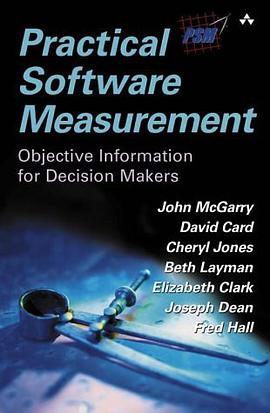

具體描述
Management by fact has become an increasingly popular concept in the software engineering and information technology communities. Organizations are focusing attention on measurement and the use of objective information to make decisions. Quantitative performance information is essential to fact-based management. Practical Software Measurement: Objective Information for Decision Makers describes an approach to management by fact for software project managers based on integrating the concepts of a Measurement Information Model and a Measurement Process Model. While these concepts apply to non-software activities as well, the examples and terminology presented in this book focus primarily on software. The information needs of the decision maker drive the selection of software measures and associated analysis techniques. This is the premise behind the widely accepted approaches to software measurement, including goal/question/metric (Basili and Weiss, 1984) and issue/category/measure (McGarry et al., 1997). Information needs result from the efforts of managers to influence the outcomes of projects, processes, and initi-atives toward defined objectives. Information needs are usually derived from two sources: (1) goals that the manager seeks to achieve and (2) obstacles that hinder the achievement of these goals. Obstacles, also referred to as issues, include risks, problems, and a lack of information in a goal-related area. Unless there is a manager or other decision maker with an information need, measurement serves no purpose. The issues faced by a software project manager are numerous. Typically they include estimating and allocating project resources, tracking progress, and delivering products that meet customer specifications and expectations. A Measurement Information Model defines the relationship between the information needs of the manager and the objective data to be collected, commonly called measures . It also establishes a consistent terminology for basic measurement ideas and concepts, which is critical to communicating the measurement information to decision makers. The information model in Practical Software Measurement (PSM) defines three levels of measures, or quantities: (1) base measures, (2) derived measures, and (3) indicators. It is interesting to note that the three levels of measurement defined in the PSM information model roughly correspond to the three-level structures advocated by many existing measurement approaches. Examples include the goal/question/metric (Basili and Weiss, 1984), factor/criteria/metric (Walters and McCall, 1977), and issue/category/measure (McGarry et al., 1997) approaches already in use within the software community. A similar approach for defining a generic data structure for measurement was developed by Kitchenham et al., who defined their structure as an Entity Relationship Diagram (1995). An effective measurement process must address the selection of appropriate measures as well as provide for effective analysis of the data collected. The Measurement Process Model describes a set of related measurement activities that are generally applicable in all circumstances, regardless of the specific information needs of any particular situation. The process consists of four iterative measurement activities: establish, plan, perform, and evaluate. This process is similar to the commonly seen Plan-Do-Check-Act cycle (Deming, 1986). Recognition of a need for fact-based, objective information leads to the establishment of a measurement process for a project or an organization. The specific information needs of the decision makers and measurement users drive the selection and definition of appropriate measures during measurement planning. The resulting measurement approach instantiates a project-specific information model identifies the base measures, derived measures, and indicators to be employed, and the analysis techniques to be applied in order to address the project's prioritized information needs. As the measurement plan is implemented, or performed, the required measurement data is collected and analyzed. The information product that results from the perform measurement activity is provided to the decision makers. Feedback from these measurement users helps in the evaluation of the effectiveness of the measures and measurement process so that they can be improved on a continuing basis. The basic concepts presented in this book evolved from extensive measurement experience and prior research. They were previously introduced in sequentially released versions of Practical Software Measurement (McGarry et al., 1997) and were formalized in ISO/IEC Standard 15939-;Software Measurement Process (2001). The measurement process model and measurement terminology from ISO/IEC 15939 have also been adopted as the basis of a new Measurement and Analysis Process Area in the Software Engineering Institute's Capability Maturity Model Integration (CMMI) project (CMMI Development Team, 2000). This book explains how software development and maintenance organizations can implement a viable measurement process based on the proven measurement concepts of ISO/IEC 15939 and the CMMI in a practical and understandable manner. In simplistic terms, implementing an objective measurement-by-fact process for a software-intensive project encompasses defining and prioritizing the information needs of the project decision makers through the development of a project-specific information model and then tailoring and executing a project-specific set of measurement process activities. The PSM approach to accomplishing this integrates prior experience and research from many sources across many application domains. Practical Software Measurement is structured to provide progressive guidance for implementing a software measurement process. It provides comprehensive descriptions of the Measurement Information Model and the Measurement Process Model, as well as experience-based guidance for applying these models in an actual project environment. No book could ever capture all of the pertinent information and practical examples related to software measurement. As such, the Practical Software Measurement Web site at www.psmsc.comcontains additional information, guidance, examples, and tools to augment Practical Software Measurement. To enhance readability, the authors have limited most of the in-text references to suggestions for further reading on specific topics. Additional references are provided in the bibliography. The following topics are addressed in this book: Chapter 1: Measurement: Key Concepts and Practices. Chapter 1 provides an overview of software measurement, explaining how measurement supports today's information-oriented business models and how measurement can become a corporate resource. It describes the relationships between project- and organizational-level measurement, and introduces the two primary concepts of PSM: the Measurement Information Model and the Measurement Process Model. Chapter 2: Measurement Information Model. Chapter 2 presents an in-depth discussion of the Measurement Information Model and its measurement components. It relates the Measurement Information Model to measurement planning and implementation activities. Chapter 3: Plan Measurement. Chapter 3 is the first of five chapters that look at the individual measurement process activities in detail. Chapter 3 focuses on the Plan Measurement activity and describes what is required to define an information-driven, project-specific measurement plan. Chapter 4: Perform Measurement. Chapter 4 addresses the Perform Measurement activity and discusses how to collect and analyze measurement data. It introduces several concepts related to measurement analysis, including the types of analysis and how to relate information needs and associated issues in terms of cause and effect. Chapter 5: Analysis Techniques. Chapter 5 provides an in-depth treatment of the three primary types of measurement analysis: estimation, feasibility analysis, and performance analysis. Chapter 6: Evaluate Measurement. Chapter 6 describes the Evaluate Measurement activity. It focuses on the assessment, evaluation, and improvement of applied project measures and the implemented project measurement processes. Chapter 7: Establish and Sustain Commitment. Chapter 7 explains the final measurement activity, Establish and Sustain Commitment, which addresses the organizational requirements related to implementing a viable project measurement process. Chapter 7 also addresses measurement lessons learned. Chapter 8: Measure for Success. Chapter 8 reviews some of the major concepts presented in this book and identifies key measurement success factors. Appendix A: Measurement Construct Examples. Appendix A provides detailed examples of measurement constructs typically applied to software-intensive projects. Appendix B: Information System Case Study Appendix B provides a comprehensive case study that addresses the implementation of a measurement process for a typical information system. Appendix C: Synergy Integrated Copier Case Study. Appendix C is a second case study that describes how measurement can be applied to a major software-intensive upgrade project. 0201715163P10012001
著者簡介
圖書目錄
讀後感
評分
評分
評分
評分
用戶評價
相關圖書
本站所有內容均為互聯網搜索引擎提供的公開搜索信息,本站不存儲任何數據與內容,任何內容與數據均與本站無關,如有需要請聯繫相關搜索引擎包括但不限於百度,google,bing,sogou 等
© 2025 book.quotespace.org All Rights Reserved. 小美書屋 版权所有




















